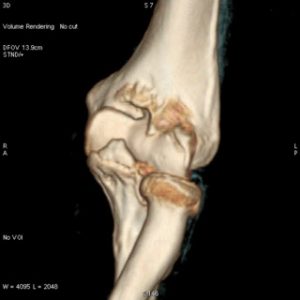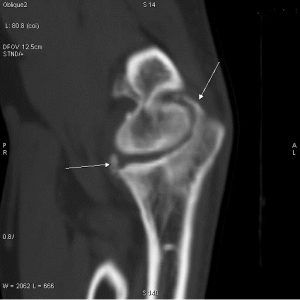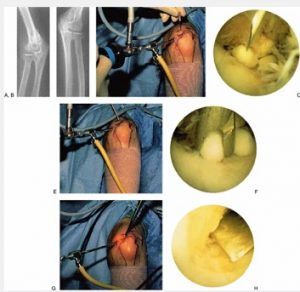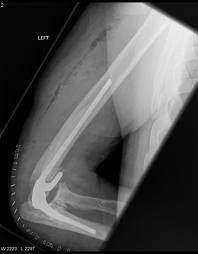What is it?
Arthritis of Elbow joint can be of two types .Primary Osteoarthritis or Rheumatoid arthritis. Arthritis means wear and tear of the cartilage of joint. Normal joint has cartilage which provides lubrication for smooth gliding of joint. In arthritis this cartilage wears away resulting in roughening of joint surface .The body forms new bone around the worn joint and these are called “osteophytes” and these can reduce movements of joint

What is its cause?
The most common cause of elbow arthritis is due to ageing. There is wear and tear of joint and this is called “Primary Osteoarthritis”. Sometimes arthritis can occur in this joint after a previous Elbow fracture or dislocation. This type of arthritis is called “Secondary Post traumatic arthritis”. In case of Rheumatoid arthritis the body’s own immune system mistakenly forms cells that damage joint cartilage.
What are the symptoms and how is elbow arthritis diagnosed?
The early symptom is stiffness of elbow and pain gradually worsens as arthritis becomes worse. Some patients develop symptoms of “locking” which is caused by loose bodies which get dismantled from arthritis bone and get lodged inside the joint.
The pain gradually worsens and causes limitation to day to day activities. The pain is especially worse after lifting activities. Sometimes the nerve around the funny bone (medial epicondyle) can get compressed and the patient can experience tingling/weakness of hand.
Will further tests or investigations be needed?
X rays are usually needed to assess extent of arthritis. MRI Scan/CT scan would be needed to plan treatment. Sometimes a Nerve conduction study would be required to assess whether the nerve is compresses at elbow.

What is the treatment?
1. Initial conservative management include Pain Killers, Physiotherapy and splinting. If the nerve is compressed it requires surgery to release the pressure at the level of elbow even at early stages. This is to prevent further deterioration secondary to compression of nerve.
2. Key Hole Surgery(Arthroscopy)- If the patients predominant symptoms are “locking” and loss of movement , this can be helped by doing a key hole operation to remove loose bodies from joint. This immediately alleviates the symptoms.
Arthroscopic (Key Hole Surgery) involves two small stab incisions are made in the elbow through which small telescope and instruments are used to remove loose bodies, inflammatory tissue or bony spurs.

3. Elbow debridement (OK procedure): This type of surgery is advised for marked arthritis that is causing significant loss of movement and pain. An incision of about 10cm is needed on the back of the elbow. At surgery all loose bodies and bony spurs that are blocking movement are removed. A fenestration is made in the distal humerus (end of the arm bone) and loose bodies or spurs in the front of the elbow are also removed. The elbow is put in a splint, in an extended position, at night only, for 2-3 weeks. Physiotherapy after surgery is critical.
4. Total elbow replacement: Joint replacement of the elbow is usually a successful operation. The pictures below show x-rays of the replacement in a patient who has rheumatoid arthritis. Replacement is usually avoided in young people but is a good option for patients with rheumatoid arthritis or those having low demands on the elbow. The operation will lead to significant pain relief and improved functional range of movement. The elbow in put in splint, in an extended position, at night only, for 2-3 weeks. Physiotherapy after surgery is critical.

What happens if it is not treated?
Some patients are able to cope with pain and conservative measures are usually enough to alleviate symptoms. Some patients have progression of arthritis and the pain worsens with limitation of range of movements.
What is the success of surgical treatment?
Arthroscopic removal of loose bodies will nearly always stop symptoms such as locking. More than 80% patients will achieve a better range of movement and significant improvement in their pain after debridement of the elbow. In more than 95% of patients, the elbow replacement will lead to a pain free elbow with a good functional range of movement.
What are the complications of surgical treatment?
Scar tenderness, Nerve damage, Persistant symptoms are all possible complications after surgery. In the long term, the elbow joint replacement may fail and will need to be revised. However, it is expected that nearly 90% of elbow replacements will still be successful after 10 years, in low demand patients.
Any surgical intervention has the risk of developing complications / setbacks which are unpredicted. These complications may have the potential to leave the
patient worse than before surgery..
When can I do various activities?
Following arthroscopic surgery, patients should be able to return to a desk job within 7 days.
Following elbow debridement or replacement, patients should be able to return to a desk job within 4-6 weeks of the operation and perform reasonable tasks with the limb by that time.
Manual work after surgery should be avoided for 8-12 weeks.
References:
1.Master Techniques in Orthopaedic Surgery: The Elbow, 2nd Edition
Copyright ©2002 Lippincott Williams & Wilkins

